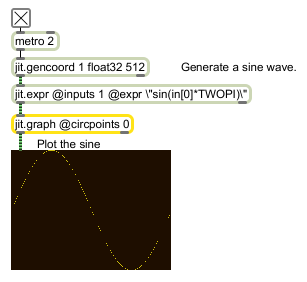| Name |
Type |
g/s |
Description |
| brgb |
int |
|
Three chars represent the red, green and blue values of the background color to render |
| clearit |
int |
|
If non-zero the cells of the matrix will be cleared to the brgb color before rendering. |
| frgb |
int |
|
Four chars represent the alpha, red, green and blue values of the color to render |
| height |
int |
|
The height of the output matrix (default=240) |
| mode |
int |
|
Five different modes are possible: mode 0 renders points, mode 1 renders lines, mode 2 renders area between the float value and the horizontal axis at 0.0, and mode 3 renders the area in a bipolar way (reflected in the horizontal axis). Unlike the other modes, which all expect one-dimensional matrices, mode 4 expects a two dimensional matrix, with one row of upper and one row of lower values, which it then renders as vertical bars, coloring the space between the lower and upper values. |
| rangehi |
float |
|
The floating point value to map to the top of the graph (default=1.0) |
| rangelo |
float |
|
The floating point value to map to the bottom of the graph (default=-1.0) |

